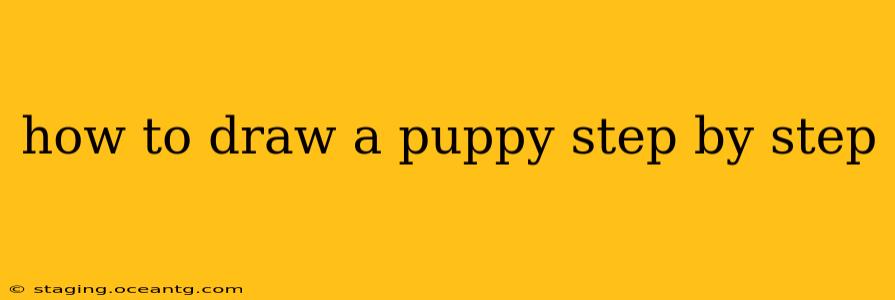Drawing a puppy can be a fun and rewarding experience, regardless of your skill level. This step-by-step guide will walk you through the process, from basic shapes to adding adorable details. Whether you're a complete beginner or looking to refine your skills, you'll find valuable tips and techniques here.
Materials You'll Need:
- Paper: Use drawing paper or a sketchbook.
- Pencil: A standard HB or 2B pencil is perfect for sketching.
- Eraser: A good eraser is crucial for correcting mistakes.
- Sharpener: Keep your pencil sharp for clean lines.
- (Optional) Colored pencils, markers, or crayons: To add color and personality to your puppy drawing.
Step 1: The Basic Shapes – Laying the Foundation
Begin by sketching simple shapes to form the puppy's body. Think of a circle for the head, a slightly elongated oval for the body, and smaller circles or ovals for the legs. Don't worry about making them perfect; these are just guides.
Step 2: Defining the Puppy's Features
Now, let's start to refine those basic shapes. Using your pencil, lightly sketch in the puppy's eyes, nose, and mouth. For the eyes, draw two small circles, and then add smaller circles inside for the pupils. The nose can be a small triangle or an upside-down "V." A simple curved line can represent the mouth.
Step 3: Adding the Legs and Tail
Connect the circles you drew for the legs to the body, making sure they are appropriately proportioned. Puppies often have somewhat chubby legs. Add a tail – a slightly curved line extending from the back of the body. Experiment with different tail positions; a wagging tail adds personality!
Step 4: Refining the Body and Adding Fur
Use your pencil to gently connect the shapes, creating a smooth outline for the puppy's body. Pay attention to the curves and soft edges of a puppy's form. You can also begin to suggest fur texture by adding short, light strokes around the body.
Step 5: Adding Details – The Finishing Touches
Now for the fun part! Add those charming puppy details. Consider adding floppy ears, a playful tongue, and maybe even a collar. You can add more detailed fur strokes for a fluffier look, depending on the breed you are trying to draw. Remember that less is often more when it comes to adding details – keep it cute and simple.
Step 6: Erase Guidelines and Refine Lines
Once you're happy with your drawing, carefully erase the initial guideline shapes. Then, go over your final lines, making them darker and more defined where necessary.
How to Draw Different Puppy Breeds?
What are some common characteristics of different puppy breeds?
Different breeds of puppies have unique features. For instance, a dachshund has long body and short legs, while a German Shepherd has pointed ears and a sturdy build. Observing reference images of the breed you wish to draw is key to capturing its distinct characteristics.
How do I draw a puppy with realistic fur?
To draw realistic fur, focus on varying the direction and length of your strokes. Use lighter strokes for areas where the fur is thinner and darker strokes for denser areas. Observe how light and shadow interact with the fur to create depth and dimension.
What if my puppy drawing doesn't look perfect?
Don't worry if your puppy drawing doesn't look exactly like the reference image. Drawing is a process of learning and experimenting. The most important thing is to have fun and enjoy the creative process.
Adding Color (Optional)
If you wish to add color, use colored pencils, markers, or crayons to bring your puppy to life. Start with light layers of color and gradually build up the intensity. Don’t be afraid to experiment with different shades and techniques.
By following these steps and practicing regularly, you'll improve your ability to draw adorable puppies. Remember, practice makes perfect! Have fun and unleash your creativity!
